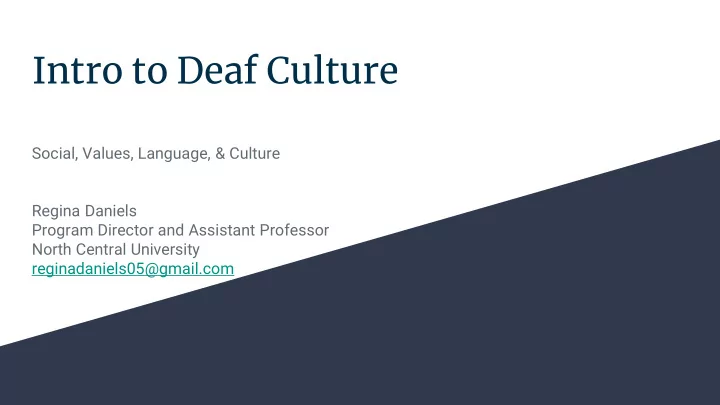

Intro to Deaf Culture Social, Values, Language, & Culture Regina Daniels Program Director and Assistant Professor North Central University reginadaniels05@gmail.com
Who am I?
My Family and our generation
What is Culture? Binds a community or group through: Shared language Shared experiences Social behaviors Community art Traditions Deaf vs. deaf Cultural identity Medical status
History of Deaf American Sign Language (ASL) started in the 1800s via Thomas Hopkins Gallaudet and Laurent Clerc. Culture Many children are born deaf due to genetic deafness, illness during pregnancy, or become deaf through illness or injury during early life. Many of these children have hearing parents and many of these parents do not use ASL to communicate with their child. Children who are deaf with hearing parents gain culture from interaction with Deaf community members. n about the language of ASL.
● Greetings signs Hello, how are you? I am good or great. ● Introducing My name is Regina Daniels (fingerspelling the name) yourselves How can I help you? ● providing Where? Who? What? How? assistance if - I will be showing you basic signs - you can introduce yourself to each other. We will review needed the signs and if any questions you want to know how to sign, please raise hand to let me know. ● what is around you and me
ASL is used in Deaf American Sign Language is the heart of our culture and ties our community together. It is how we share Culture - why? our traditions, oral history, and culture. ASL uses: 1. Facial expression 2. Handshapes 3. Palm orientation 4. Movement 5. Location 6. Body language 7. Gestures 8. Classifiers 9. Space
History of Modern Deaf Culture and the American Deaf community has its core in residential schools. These schools serve as Deaf Culture cultural hubs for Deaf children where they are educated in core subjects (mathematics, English, science, etc.) and skill and team building activities (athletics, student government, theater, etc.). Typically, these students go on to post-secondary institutions such as Gallaudet University and the Rochester Institute of Technology (RIT).
Languages/ Communication Credit to De’ VIA Art
How we Deaf/Hard of Hearing (HOH) have ways to communicate with each other. We rely on visual, communicate and physical, and eye contacts. what we do in the visual such as lights will turn on and off, hand ● waves, stomp the floor, or tap on the table Deaf Community Using interpreters to communicate ● physical contacts (we need to touch in order to ● get your attention) - this may be uncomfortable to some of you but just be aware that we do touch (on the shoulders, arms, or legs). ● When communicating with deaf and HOH people, we use interpreters but when speaking to the person (not interpreters)- look at the deaf or hoh person.
ASL and Deafness is core to an individual’s identity. Deaf Identity Oppression Alexander Graham Bell; Milan Conference Oralism Movement Modes of Communication (SEE, MCE, etc.) Deaf Identity Development Interaction with Deaf community Use of ASL as L1 Self-acceptance of Deafness My Identity
Dr. Carolyn McCaskill’s experience with Deaf Culture Shock
Any other reason? Modern trends in Deaf awareness places emphasis on hearing students understanding their privilege as hearing people. Some examples of Hearing Privilege are: Understanding orders given from an officer Hearing important information over the loudspeaker What are some examples of Deaf Privilege?
Role play activities ● We will be doing role play with the abc’s , introduction, and create a dialogue with each other.
Wrap Up & Culture Questions History and Aspects of Deaf Culture ASL Deaf Identity Why ASL is integral in the Deaf Community Importance of accessibility Privilege
Recommend
More recommend